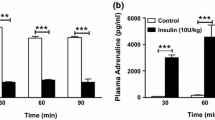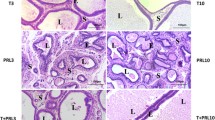Abstract
This study evaluated the roles of protein dephosphorylation or suppressed gene expression in reducing tyrosine hydroxylase activity in tuberoinfundibular dopaminergic neurons after acute or chronic bromocriptine (BROMO) administration. Diestrous or ovariectomized rats were injected with BROMO (3 mg/kg, s.c.) at 1000 h and were sacrificed 4 h later or were injected with BROMO at 12 h intervals for 3 days.In vitro tyrosine hydroxylase activity was assessed by incubating hypothalamic explants with brocresine, an L-aromatic amino acid decarboxylase inhibitor, and measuring 3,4-dihydroxyphenylalanine (DOPA) accumulation in the stalk-median eminence (SME). The incubation medium also contained either 2 μM okadaic acid, a protein phosphatase 1 and 2A inhibitor, or its vehicle (0.25% dimethylsulfoxide). Acute (4 h) and chronic (3 days) BROMO treatment suppressed circulating PRL levels from 10–12 ng/ml to<1 ng/ml and reduced tyrosine hydroxylase activity in the SME by 60% or 40% in diestrous or ovariectomized rats, respectively. Okadaic acid increased tyrosine hydroxylase activity in the SME 2-fold in control diestrous or ovariectomized rats. The reduced tyrosine hydroxylase activity in the SME after acute BROMO treatment was increased by okadaic acid 5-or 3-fold in diestrous or ovariectomized rats respectively, to a value similar to the controls. In sharp contrast, after chronic BROMO treatment, the response to okadaic acid was blunted. As assessed byin situ hybridization, tyrosine hydroxylase mRNA signal levels in the arcuate nucleus of diestrous rats were not altered after acute BROMO treatment, but were reduced by 70% after chronic BROMO treatment. The acute BROMO-induced decrease in tyrosine hydroxylase activity was reversed by co-administration of oPRL or rPRL, indicating that the action of BROMO is via a reduction in PRL. The data suggest that protein dephosphorylation may be a primary mechanism for the rapid BROMO-dependent suppression of tyrosine hydroxylase activity, whereas suppression of tyrosine hydroxylase gene expression may contribute to the lower tyrosine hydroxylase activity after chronic BROMO treatment.
Similar content being viewed by others
References
Arbogast, L.A. & Voogt, J.L. (1991).Endocrinology,128, 997–1005.
Ben-Jonathan, N. (1994).Endocr. Rev.,6, 564–589.
Biolojan, C. & Takai, A. (1988).Biochem J.,256, 283–290.
Björklund, A., Moore, R.Y., Nobin, A. & Stenevi, U. (1973).Brain Res.,51, 171–191.
Björklund, A., Lindvall, O. & Nobin, A. (1975).Brain Res.,89, 29–42.
Bradford, M.M. (1976).Anal. Biochem.,72, 248–254.
Chalfie, M. & Perlman, R.L. (1977).J. Pharmacol Exp. Therap.,200, 588–597.
Dahlström, A. & Fuxe, K. (1964).Acta Physiol. Scand.,62, [Suppl 232], 1–55.
Demarest, K.T. & Moore, K.E. (1979).J. Neural Transm.,46, 263–277.
Demarest, K.T. & Moore, K.E. (1980).Endocrinology,106, 463–468.
Demarest, K.T., Riegle, G.D. & Moore, K.E. (1984).Neuroendocrinology,38, 467–475.
Demarest, K.T., Riegle, G.D. & Moore, K.E. (1985).Neuroendocrinology,40, 369–376.
Galloway, M.P., Wolf, M.E. & Roth, R.H. (1986).J. Pharmacol. Exp. Therap.,236, 689–698.
Gerald, K.B. (1990).Nurse Anesthesia,1, 162–165.
Gonzalez, H.A. & Porter, J.C. (1988).Endocrinology,122, 2272–2277.
Gudelsky, G.A. & Porter, J.C. (1990).Endocrinology,106, 526–529.
Haavik, J., Schelling, D.L., Campbell, D.G., Andersson, K.K., Flatmark, T. & Cohen, P. (1989).FEBS Lett.,251, 36–42.
Kehr, W., Carlsson, A., Lindqvist, M., Magnusson, T. & Atack, C. (1972).J. Pharm. Pharmac.,24, 744–746.
Levitt, M., Spector, S., Sjoerdsma, A. & Udenfriend, S. (1965).J. Pharmacol. Exp. Therap.,148, 1–8.
Lookingland, K.J. & Moore, K.E. (1984).Brain Res.,304, 329–338.
Masserano, J.M. & Weiner, N. (1983).Mol. Cell Biochem.,53/54, 129–152.
Moore, K.E. (1987).Biol. Reprod.,36, 47–58.
Morgan, W.W. & King, T.S. (1986).Neuroendocrinology,42, 351–356.
Paxinos, G. & Watson, C. (1986). Academic Press: New York.
Romero, M.I. & Phelps, C.J. (1993).Endocrinology,133, 1860–1870.
Selmanoff, M., Shu, C., Hartman, R.D., Barraclough, C.A. & Petersen, S.L. (1991).Mol. Brain Res.,10, 277–281.
Shyr, S.W., Crowley, W.R. & Grosvenor, C.E. (1986).Endocrinology,119, 1217–1221.
Voogt, J.L., Arbogast, L.A., Quadri, S.K. & Andrews, G. (1990).Mol. Brain Res.,8, 55–62.
Zar, J.H. (1984). Prentice-Hall: Englewood Cliffs, NJ. ed. 2., pp 206–235
Author information
Authors and Affiliations
Rights and permissions
About this article
Cite this article
Arbogast, L.A., Voogt, J.L. Hypoprolactinemia decreases tyrosine hydroxylase activity in the tuberoinfundibular dopaminergic neurons acutely by protein dephosphorylation and chronically by changes in gene expression. Endocr 3, 801–806 (1995). https://doi.org/10.1007/BF02935684
Received:
Accepted:
Issue Date:
DOI: https://doi.org/10.1007/BF02935684




